
Want to cut logs without using a chainsaw? You may be looking for an environmentally friendly alternative that won’t disturb your neighbors with its deafening sound. Luckily, we have just what you need.
Cutting logs without a chainsaw is not only feasible, but it can also provide satisfaction.
But why might you want to steer clear of using a chainsaw altogether? For one thing, these tools can be heavy and unwieldy, not to mention extremely hazardous to use.
Additionally, their noise output can be an unbearable nuisance to those within earshot.
Thankfully, there are other options available to you. Hand saws, cross-cut saws, and bow saws are among the most common alternatives.
Now, we will delve into each of these options in detail to determine how they can best suit your needs.
12 Best Proven Ways To Cut Logs Without A Chainsaw
When it comes to cutting logs, most people think of a chainsaw as the go-to tool. Despite the convenience of chainsaws, not all individuals have access to one or may not be confident in their ability to handle it.
Fortunately, there exist alternative methods to cut logs without relying on a chainsaw. Whether you’re looking to economize or simply prefer using manual tools, rest assured that there are viable options available.
Let us explore some techniques you can employ to cut logs without a chainsaw.
1. Hand Saw
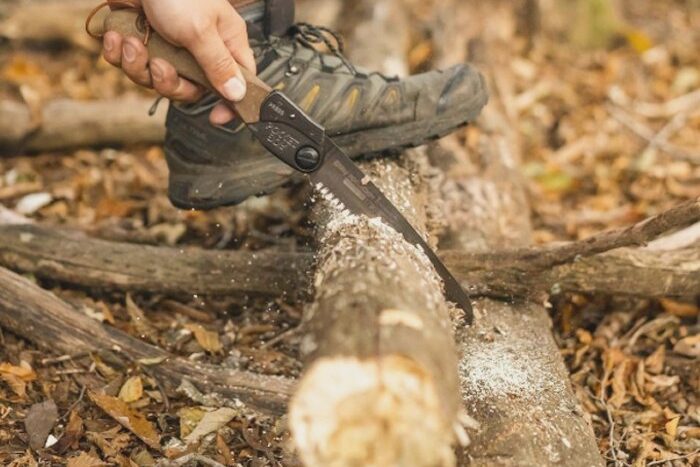
When it comes to cutting logs without a chainsaw, a hand saw is a reliable and time-honored option. This manually-operated tool consists of a long blade with sharp teeth attached to a handle, made of high-quality steel that effortlessly slices through wood.
Before using a hand saw to slice through logs, you’ll need to secure the log in place using a sawhorse or other sturdy platform.
Once the log is secured, you can proceed to measure and mark the cut line on the log using a pencil or chalk. To commence the process of cutting logs with a hand saw, one should first mark the line to ensure precision.
With the hand saw in hand, begin sawing back and forth along the marked line, maintaining a straight blade and applying even pressure to guarantee a clean cut.
Cutting logs with a hand saw is not just an activity but a source of physical exercise and fresh air. It is a simple yet gratifying task that can be easily accomplished.
Furthermore, it’s a quieter and more sustainable option compared to using a chainsaw. Additionally, a high-quality hand saw can last for decades and necessitates minimal maintenance, making it an economical choice for those who frequently need to cut logs.
2. Bow Saw
If you’re looking for a substitute for a chainsaw to chop logs, the bow saw is a great contender. Usually, this saw comes with a long and narrow blade that is tightened between two handles, with one handle curved.
The curved handle can provide better control and accuracy while slicing, making it an excellent choice for cutting logs into smaller pieces that are easier to handle.
Bow saws are an excellent alternative for those living in urban areas or places where noise pollution is a concern.
Compared to chainsaws, they are much quieter and cause less disturbance. Additionally, they are relatively lightweight, which makes them convenient to carry during hiking and camping trips.
3. Axe
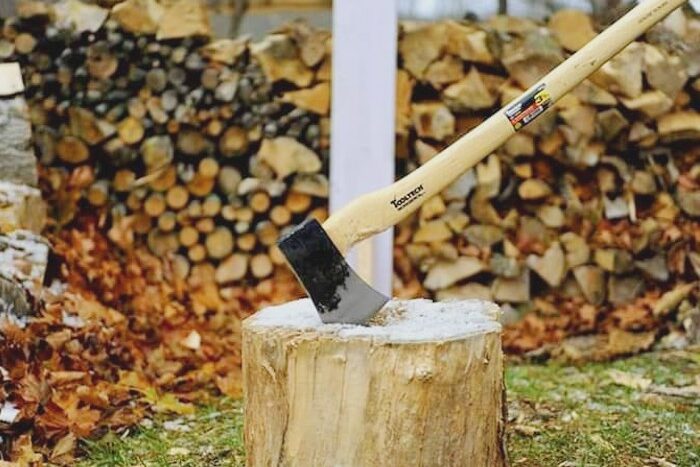
The axe has been a go-to tool for log cutting for centuries, proving its versatility and portability for various purposes such as firewood or construction. Its traditional and effective method has stood the test of time.
Selecting the right size and type of axe is crucial before beginning log cutting with an axe. To chop safely, it’s important to place the log on a secure surface and notch one side of the log to prevent the axe from slipping.
Once the log is notched, the user can strike the log on the notch and swing the axe downward with their dominant hand to cut the log into desired sizes. Using an axe instead of a chainsaw can be a satisfying and efficient way to cut logs.
4. Cross Cut

For ages, crosscut saws have been the go-to manual tool for people looking to cut logs without a chainsaw. Available in one or two-person designs, the latter is the more popular option.
Crosscut saws feature a blade that comprises sharp teeth that make cutting through wood possible. Some saws have stiff, heavy blades that are ideal for splitting trees into firewood logs. Additionally, the blade teeth have different designs to serve varying objectives.
The size and spacing of the blade teeth play a crucial role in determining the cut’s efficiency and smoothness. Crosscut saws, when used correctly, are an excellent way to make log cuts without needing power tools, making them efficient and practical.
5. Splitting Maul
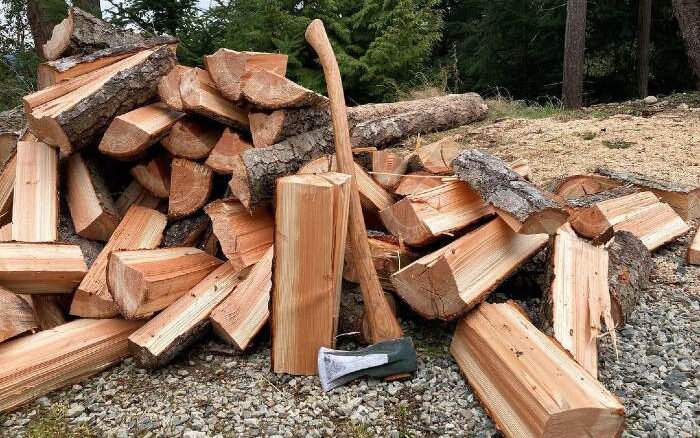
Breaking logs into smaller pieces is made easier with the use of a splitting maul, a hand-held tool that is particularly useful for cutting smaller logs or when a chainsaw is not available. The maul has a wide, heavy head that can deliver a powerful, splitting blow to split the logs apart.
Employing a splitting maul involves placing the blade on the top of the log and swinging it down with force toward the log’s center.
The maul’s weight ensures a simple split, allowing the log to be separated into smaller pieces with ease. Using a splitting maul is a secure and effective way to deal with logs when a chainsaw isn’t an option.
6. Wire Saw
The wire saw is composed of a slender wire that encircles the branch or logs you intend to sever. The wire is then drawn back and forth across the branch until it is completely sliced through. Due to its thin and pliable design, this tool is highly efficient and can be utilized to cut at any angle or direction.
Additionally, it boasts an incredibly compact and portable size, rendering it effortless to stow in your pocket.
Consequently, it’s an excellent choice for outdoor pursuits such as camping or hiking, where a chainsaw may prove cumbersome or perilous.
7. Folding Saw

Achieve precision and ease while cutting by using a folding saw with a narrow, flexible blade that has a serrated edge.
These saws are not only lightweight but also compact and easy to carry, thus making them the quintessential tool for outdoor activities like camping and hiking.
If you’re planning to cut logs using a folding saw, begin by selecting a log that can be cut by hand. Then, create a small notch in the log by using an axe or hatchet.
Finally, exert steady pressure on the saw while moving it back and forth to cut through the log. Always wear protective gloves and goggles to prevent any mishap.
8. Circular Saw
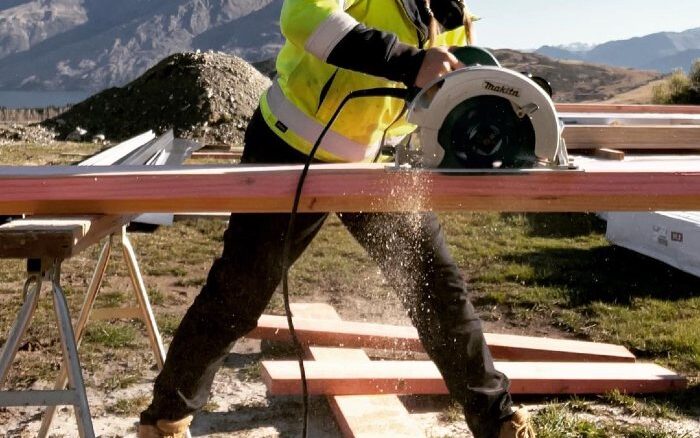
When it comes to cutting wood, chainsaws are the go-to tool for most people. However, if you’re dealing with smaller logs or don’t have access to a chainsaw, a circular saw can be a suitable alternative. These power saws use a toothed or abrasive blade to cut through various materials, including wood.
Want to turn those bulky logs into smaller, more manageable pieces for firewood or other purposes? A circular saw might be the answer.
With its high-speed rotating blade, this type of power saw can make quick work of cutting through wood.
But be warned: using a circular saw on a standing tree can be a hazardous and challenging task. It’s best to stick to cutting down trees instead.
9. Jigsaw
A jigsaw – a powerful handheld power tool – is versatile, and capable of cutting wood, metal, and other materials, even intricate shapes and curves.
While it may not be the first tool that comes to mind for cutting logs and firewood, it can be useful in specific circumstances.
Straight planks, pallets, and similarly sized pieces of wood can be easily cut into smaller pieces for firewood with a jigsaw.
The tool’s blades make quick and efficient work of the wood, outpacing hand tools by a considerable margin.
That being said, a jigsaw should not be used to cut down felled trees. The tool’s blades are too small and lightweight to handle the density and size of logs effectively.
A chainsaw or other specialized tool would be a better choice in these situations.
Additionally, if you plan to use a jigsaw for cutting firewood, it is important to have a power source available.
While there are cordless battery-powered jigsaws available, they may not have enough power to handle the job, particularly if you need to cut through thicker or denser pieces of wood.
10. Reciprocating saw
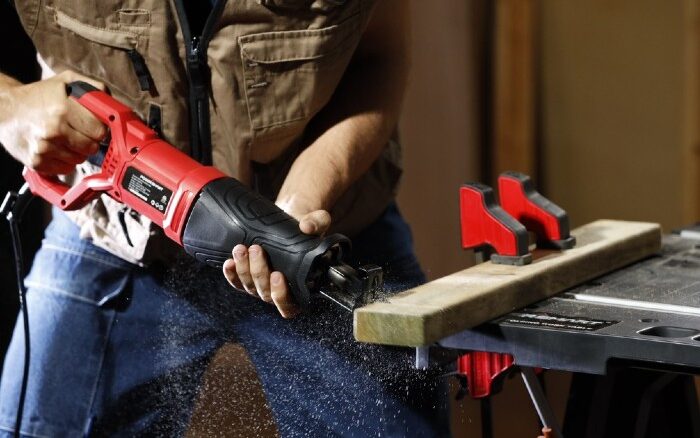
Instead of relying on a chainsaw, opt for the versatile reciprocating saw to cut logs with ease. Designed to slice through a range of materials, this tool is perfect for tackling large or awkwardly shaped logs.
The reciprocating saw offers quick and effortless cuts through logs of varying thicknesses, making it the go-to tool for any DIY or construction project. One of the major advantages of reciprocating saws is their inherent portability.
Available in both corded and cordless versions, reciprocating saws are a popular choice for cutting logs in hard-to-reach areas or for on-the-go projects. This kind of saw is just like other power equipment in terms of cordless or corded options.
The diverse selection of blade options available for the reciprocating saw is another perk for using it to cut logs. With various blades to choose from, you can make precise cuts and tailor the saw to your project’s requirements.
Whether you need to cut through wood with nails or metal, there’s a blade that’s suitable for the job. For certain applications, such as pruning or cutting through concrete, reciprocating saws can also be used in conjunction with specialized blades.
11. Miter Saw

Renowned for its adaptability, power miter saws are extensively used in both woodworking and construction projects. Its remarkable capacity to make precise cuts at various angles makes it a great substitute for chainsaws when it comes to cutting logs.
Unlike chainsaws, the angle of a miter saw can be adjusted to any degree, providing more flexibility and accuracy in sizing logs.
In addition, miter saws work much faster than chainsaws, making them a more efficient tool for log cutting. Despite these advantages, miter saws are not typically utilized for this purpose since their intended use is to cut wood into smaller, more manageable pieces.
12. By Hand
In remote areas where power tools are unavailable, cutting logs without a chainsaw is a common practice that involves using human force to break the wood into smaller pieces for firewood. To begin, gather the wood and select pieces that can be broken by hand.
Such wood includes old, dry, or rotting wood. To break it, hold it firmly on a flat, robust surface and smash it against the edge of the surface, either with half the wood on or off the surface.
Alternatively, you can lay the branch on the ground, stand on it, and pull your body weight up. This method works well for producing kindling.
However, be cautious and avoid breaking the wood over your knee to prevent any harm to yourself. For larger pieces, elevate the wood on a sturdy surface and stand on it to split it in half or into the desired length.
Alternatively, jamming a branch or a wedge into the wood and hitting it with a sledgehammer can also be effective.
The Verdict!
To sum up, cutting logs without a chainsaw can present a daunting and time-consuming challenge. However, numerous effective alternatives can streamline the process while minimizing risk.
We have detailed the top 12 methods to utilize instead of a chainsaw for log cutting. Depending on the size of the logs, hand tools like axes, hatchets, and saws can effectively handle small to medium-sized logs, while two-man crosscut saws can tackle larger ones.
The availability of these tools as well as the necessary proficiency in using them can greatly impact the overall outcome of the task. It is crucial to prioritize safety measures by donning proper protective equipment and adhering to safety guidelines.
Ultimately, the ideal approach for cutting logs without a chainsaw is subject to personal preference, skill level, and the volume and dimensions of the logs that need to be cut.
FAQs
How can I streamline the cutting process?
To make the cutting process easier, it is important to keep the saw blade sharp. You can also use a lubricant such as vegetable oil to reduce friction and make the saw glide through the log more easily.
Is it safe to cut logs without a chainsaw?
Yes, it is possible to cut logs without using a chainsaw as long as you use the proper tools and techniques. It is important to wear protective gear such as gloves and eye protection and never to cut the logs while standing on them.
Can I use an electric saw to cut logs?
Cutting logs with an electric saw is possible, but it comes at an added cost. Electric saws generally require a power source and are more expensive than hand saws, making them an impractical option for some. Moreover, electric saws can pose a safety hazard if not used properly. Hence, it is crucial to read and follow the manufacturer’s instructions before using one.

I am Senior Editor and CEO and I have been a chainsaw enthusiast for over 12 years. As a passionate chainsaw enthusiast, I have got a wealth of knowledge and experience with chainsaws, and I am constantly striving to expand my expertise and knowledge. Read More!
